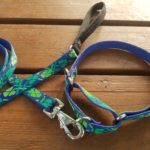Your Guide to Collar Safety
As you can imagine, safety is my primary concern when I have a dog in my care. And what’s the number one piece of safety equipment? Your dog’s collar.
I’m talking about what attaches the leash to the dog. If your collar breaks or slips off your dog’s head… you suddenly have no physical control.
For safety’s sake, let’s talk about the two main types of collars and how/when to use them properly.
Flat Buckle Collar
 This may be made out of nylon, fabric, or leather. It’s a good all purpose collar.
This may be made out of nylon, fabric, or leather. It’s a good all purpose collar.
Proper use: Collars should be snug enough that they can not be pulled off the dog’s head. You should be able to fit not more than two fingers under the collar. If your dog has a very small head (like a greyhound) or a very thick neck (like a pitbull), avoid the flat buckle collar and opt for a martingale collar instead.
Warnings: Do not purchase cheap collars. I have seen too many snaps break under pressure. Also, be very careful that the fabric doesn’t stretch. There are several great brands, and my favorite is Lupine Pet.
Martingale Collar
 These look like a regular collar around the bottom with a loop of fabric or chain at the top. The idea is that the collar is loose enough to be comfortable, but will tighten by a few inches if the dog pulls. It should tighten just enough that the collar can not slip over the dog’s head.
These look like a regular collar around the bottom with a loop of fabric or chain at the top. The idea is that the collar is loose enough to be comfortable, but will tighten by a few inches if the dog pulls. It should tighten just enough that the collar can not slip over the dog’s head.
Proper use: Again, this style must be snug enough. If you pull the collar tight and it still can slip over your dog’s head, it’s too loose. Depending on the style (and the shape of your dog’s head/neck), you have to slip these over the head then tighten them.
Some people like these collars because they’re kinder on the dog’s neck. If a dog pulls on a flat buckle collar, all of the  pressure is applied directly to the front of the dog’s neck. If a dog pulls on a properly fitted martingale, the pressure is distributed evenly around the dog’s neck, resulting in less pressure on the trachea.
pressure is applied directly to the front of the dog’s neck. If a dog pulls on a properly fitted martingale, the pressure is distributed evenly around the dog’s neck, resulting in less pressure on the trachea.
Warnings: Make sure to attach your collar to the live ring, not the dead ring. The live ring will make the collar tighter if the dog tries to pull away. The dead ring does not make the collar tighter, and your dog may slip out of the collar.
Slip Leads
 At Flying Colors, our preferred collar isn’t really a collar at all. It’s a slip lead; a collar and leash in one. It’s versatile. One size fits all dogs. We can even use it as a head halter. But above all, the lack of hardware (buckles and snaps) means that there’s no hardware to fail. The style we use has a plastic stopper which prevents the collar from falling off.
At Flying Colors, our preferred collar isn’t really a collar at all. It’s a slip lead; a collar and leash in one. It’s versatile. One size fits all dogs. We can even use it as a head halter. But above all, the lack of hardware (buckles and snaps) means that there’s no hardware to fail. The style we use has a plastic stopper which prevents the collar from falling off.
Proper use: If the stopper is not properly tightened, the collar piece may get too loose and fall off.
Warning: The slip lead will get tighter and tighter the more a dog pulls. So it’s very important that this tool is used with dogs who are learning to not pull. Never leave this type of collar on while a dog is unattended.
General Safety Warnings
Dogs should not wear collars while crated. Collars and tags can become caught in the bars and result in serious injury or death.
If your dog wrestles with other dogs, collars pose a serious risk. One dog’s jaw can become caught around the other dog’s collar, resulting in suffocation.
To be honest, my dogs do not wear collars while they’re home. Yes, this means they don’t have name tags on. But they ARE micro-chipped. And their name tag collars are definitely used for trips.
I didn’t address training collars, head halters, and harnesses. But now you a better understanding of the two most common types of collars, as well as an introduction to slip leads. Remember… safety first!



